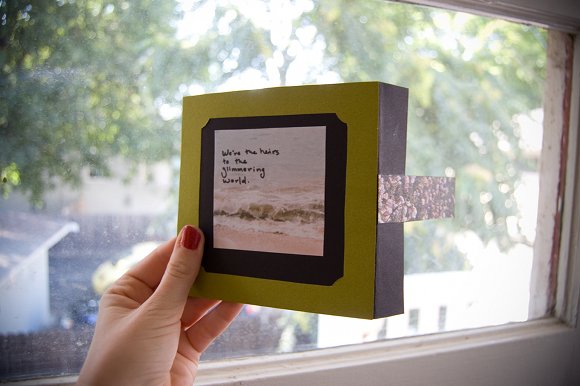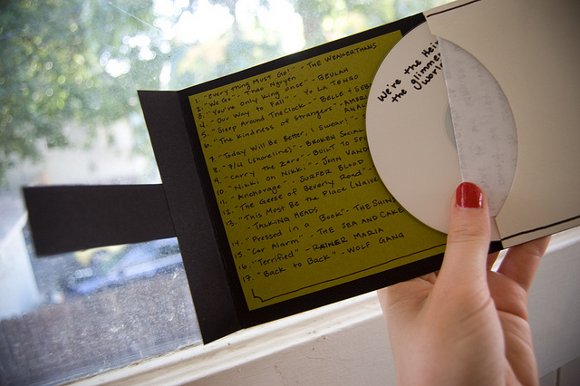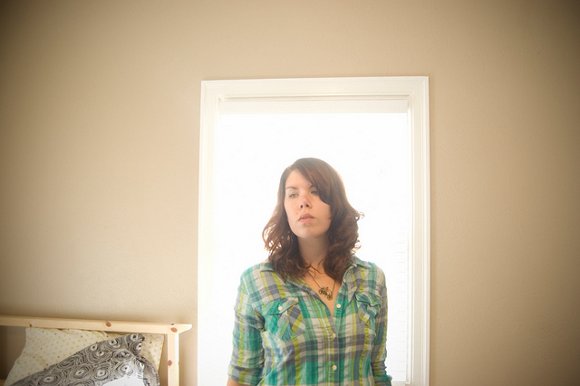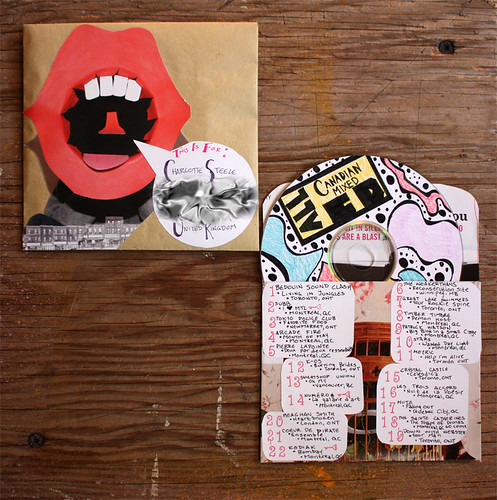
You hear the repeated chorus: music in the digital age has become meaningless and valueless, like turning on water from a tap in the middle of Rome. But, quietly, a movement is stirring that is reclaiming the value of music. Armed with nothing more sophisticated than markers, paper, collage materials, and imagination, they send mixes of music like grade school Valentines. Heck, they even use the mail. It makes the album more personal than it was even in its golden, mass-produced age.
Many of the practitioners in this case are returning to the cassette and mix tape. But I was also interested in handcrafting cases for demos, for your own music, and for mixes of Creative Commons-licensed and netlabel materials. Instead of just swapping behind our avatars and usernames on SoundCloud, it returns us to the glee of playing with markers and exchanging face-to-face.
If you’re in New York, we’ll be making our own musical packaging and then swapping records, starting with a 4:00 pm workshop on this Sunday 10/10/10 at the Lower East Side’s cozy (and tapas- and drink-stocked) Culturefix NY:
RSVP + location + Facebook; stay for the party, live music, and swap at 7p
But wherever you are, perhaps this Sunday you can make some handmade music.
Here’s a look at some of the work being done, via a Flickr group entitled “Handmade Mixes,” in a Flickr slideshow:
Group founder Samantha Saturday talks to CDM about her techniques, and gives us some crafting tips. Keeping it simple makes this manageable, too, in case you’re planning a handmade, limited edition-run of your next EP.
Tips for materials:
For collaging works I always keep a shoebox of paper scraps and snippets from newspapers, magazines, flyers, basically anything that can be glued or taped down. Keeping all your supplies close at hand is a huge help. Personally I make all my cases completely from scratch, but sometimes starting out with a pre-made CD sleeve and building on top of it is a great way to start.
My best advice is to keep the process fun and to not put too much pressure on yourself to make something totally awesome. If you just let it happen it will be awesome no matter what. There is no right or wrong way to do it.
What to bring to a workshop: (including ours on Sunday!)
Bring mixes specifically for the event and some paper, magazines, glue, snippets, or what have you to share with the workshop.
I talked to Sam about some other ideas, too…
Tell us what you’ve been making.
All of the works I have made are either for friends or for mix trades organized in different places around the internet, such as blogs and Swap-bot [an online-organized swap meet]. For every mix I make, I also create a collaged, cut & paste cover. Some are simpler than others, but I always try to make something nice to house all this great music.
In general I put so much effort and time into making individual covers for every mix because I feel that with the digital age music is starting to lose some of it’s specialness. There’s something about having album artwork to accompany the music you’re listening to. Now you don’t really get that with digital downloads and I miss that. I think it’s the same for a lot of the people who are so dedicated to creating unique artwork.
Who are some of the other people you’ve found working in this medium?
Jane Boston (Stab Heart zine) and Bianca Jagoe (Goodnight Little Spoon) are the first that come to mind. They are both pretty big swappers in the online and mail art community. I’ve sent to and received mixes from both of them and I adore the love they put forth in their creations.
Additionally some of the people that have really stood out to me are Richard Gallon [Flickr] and Evey in Orbit [Flickr. Richard creates really well-crafted covers for his cassettes. On the other hand Evey has a much more cut-and paste approach to it. Even though their techniques are very different I love the range that can be expressed because it’s such an open medium.
I created the Flickr group Handmade Mixes for people to share their handmade covers, since it seems like every other mix group is mostly computer-generated works. Most of the people who contribute are people I invited, but a few other people are popping up here and there, which is so exciting! Everyone in the group does a great job and it’s really inspirational to see that there are lots of people out there who make their own covers, too.
Introduce us to one of your favorite mixes.
My mix “We’re the Heirs to the Glimmering World” is definitely one of my favorite mixes that I’ve made, both because of the music and the cover art. Usually if I’m feeling a little down I will make a mix to focus my mind on something else and that was definitely the case with this mix. It’s one of the most elaborate covers I’ve made.

You mention on one of the Flickr images that some of these mixes came from getting together for an in-person swap.
[That’s] Mix Share Swap hosted by Bianca Jagoe of Goodnight Little Spoon. I found out about the swap from Jane Boston’s blog. If you keep your eye out, there are a lot of mix swaps like this around the blogosphere. Anyone could sign up, then you were assigned two random people you would send to from the list and you received mixes from two different people. It’s a great way to share music and connect with other people.
Any thoughts on how you translate the personality of a music mix to the visuals on the handmade packaging? (It’s an age-old question, of how to make something visual out of the auditory and ephemeral.)
When I make a mix the music, of course, always comes to mind first. After, and sometimes during, compiling a mix you listen to it and different themes or a general feel to the music will come forward and I think that’s where ideas for the packaging first start to form.
Everyone has their own aesthetic and although it sounds cliché it’s definitely about putting together what feels right. Sometimes the cover doesn’t necessarily tie in directly with the music, but generally I think there is something in the sub-conscience that drives the creation. Also, the handmaking process is a lot different than say, someone creates a cover on a computer. You’re connecting with the mix on a tactile level and that alone comes through in the visuals.

More inspiration:
Check out Sam’s Flickr: Handmade album
and the Handmade Mixes group on Flickr (which I hope will also apply to original music, CC-licensed music)
All images courtesy Samantha Saturday.
Below, some of Sam’s favorites from her group.


